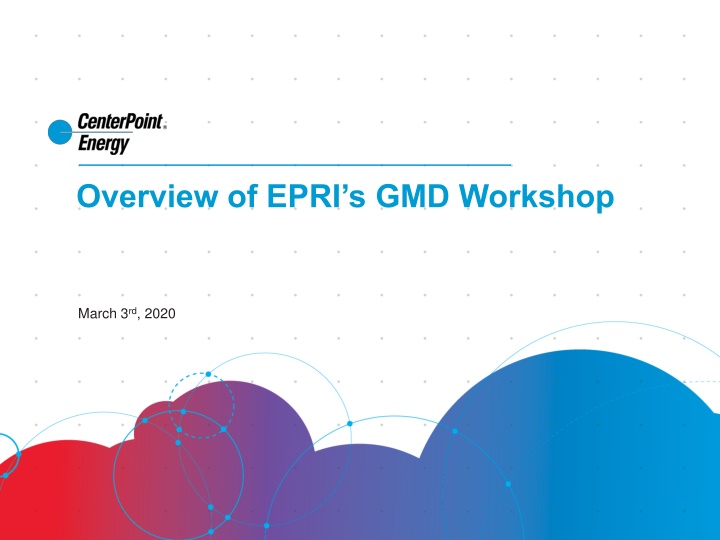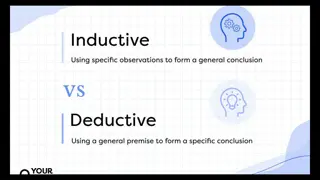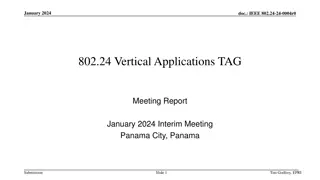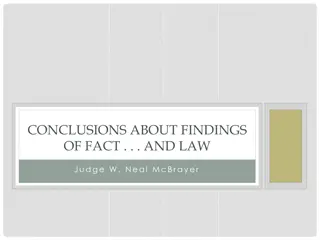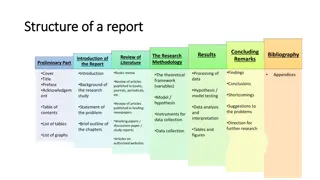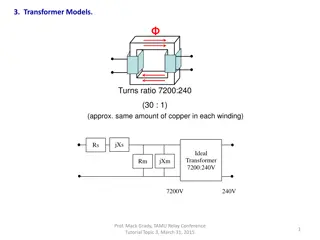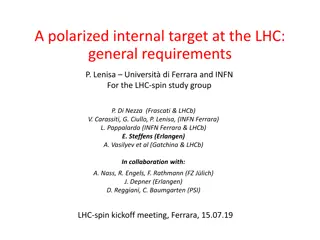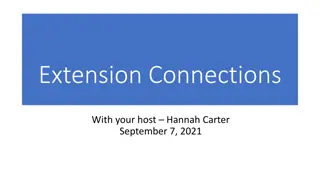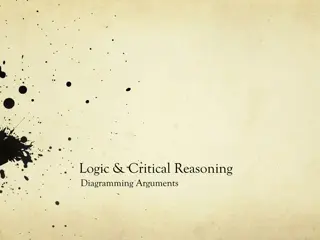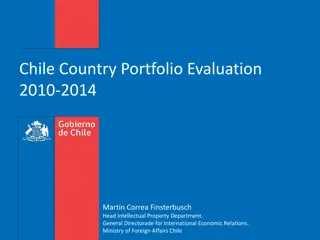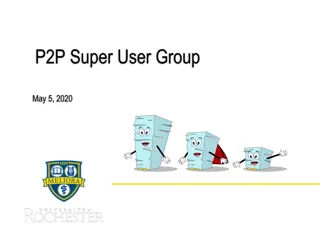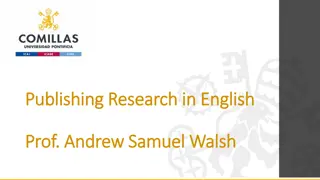EPRI's GMD Research Updates and Preliminary Conclusions
EPRIs GMD workshop presented updates on research projects focusing on the impacts of geomagnetic disturbances (GMD) on the bulk power system. The workshop highlighted ongoing and upcoming projects, including assessments of transformer thermal impacts, GIC estimation models, geoelectric field enhancements, and more. Preliminary conclusions revealed details on the impact of localized geoelectric field hotspots on transformer GIC current and the effects on core saturation losses.
Download Presentation

Please find below an Image/Link to download the presentation.
The content on the website is provided AS IS for your information and personal use only. It may not be sold, licensed, or shared on other websites without obtaining consent from the author.If you encounter any issues during the download, it is possible that the publisher has removed the file from their server.
You are allowed to download the files provided on this website for personal or commercial use, subject to the condition that they are used lawfully. All files are the property of their respective owners.
The content on the website is provided AS IS for your information and personal use only. It may not be sold, licensed, or shared on other websites without obtaining consent from the author.
E N D
Presentation Transcript
Overview of EPRIs GMD Workshop March 3rd, 2020
UPDATES ON EPRI RESEARCH OF GMD IMPACTS ON THE BULK POWER SYSTEM EPRI GMD Supplemental Project Releases: Updated ID# 3002014854 version of the Harmonic Tool (GICharm) v1.0: GIC Harmonic Analysis (Accompanying report): ID# 3002017447 Transformer Thermal Impact Assessments for DC Withstand Capability: Examining the Impacts of GIC on Transformer Thermal Performance: ID# 3002017708 Assessment Guide: GMD Harmonic Impacts and Asset Withstand Capabilities (Generator impact update): ID# 3002017707 GMD Vulnerability Assessment and Planning Guide, reissued in December 2019: ID# 3002016209 Two-year research effort with EPRI concludes Q1 2020, with all remaining reports to be published by March 31, 2020. 2 EMAIL QUESTIONS TO VIKKI.CLARK@CENTERPOINTENERGY.COM PROPRIETARY AND CONFIDENTIAL INFORMATION
UPDATES ON EPRI RESEARCH OF GMD IMPACTS ON THE BULK POWER SYSTEM EPRI Upcoming Research Product Releases: GIC Transformer Thermal Impact Assessment: Impact of Field Orientation on Transformer Thermal Screenings: ID# 3002017948 Magnetohydrodynamic Understanding of Geoelectric Field Enhancements (GEF) and Auroral Behavior during GMD Events: ID# 3002017952 (MHD) Modeling for the Further Furthering the Understanding of the Characteristics and Scales of GFE: ID# 3002017900 Improving Conductivity Models for GIC Estimation: Guidance for Validation of GIC Models: ID# 3002017897 Update of Earth Response Scaling Factors using Magnetotelluric (MT) Measurements: ID# 3002017899 Non-Uniform Field : Coast Effect Assessment: ID# 3002017898 3 EMAIL QUESTIONS TO VIKKI.CLARK@CENTERPOINTENERGY.COM PROPRIETARY AND CONFIDENTIAL INFORMATION
EPRI PRELIMINARY CONCLUSIONS Results of Evaluating the Impact of Localized Geoelectric Field Hotspots on Transformer effective GIC current. Most transformers impacted by an increase in GIC are within the hotspot area. For the 200 km X 200 km geoelectric field enhancement, the overall incremental impact is modest, and it is not expected to lead to widespread stress in the system. Most significant increases were observed in the Northeast (as opposed to other investigated locations, due to higher geoelectric fields) The regionally-averaged geoelectric field time series, a hotspot T of 200 C can be reached with peak GIC(t) between 68A and 98A per phase. The single-station geoelectric field time series, a hotspot T of 200 C could be reached with peak GIC(t) between 73A and 90A per phase. 4 EMAIL QUESTIONS TO VIKKI.CLARK@CENTERPOINTENERGY.COM PROPRIETARY AND CONFIDENTIAL INFORMATION
EPRI PRELIMINARY CONCLUSIONS Losses in the tertiary winding increases due to the core saturation, especially the Eddy losses increase significantly compared to the nominal condition without DC. Study shows, that no critical steady-state temperatures are reached, even with 200 A DC per phase in the high-voltage winding. Study shows, that the nominal condition of losses (nominal rating) can be easily exceeded due to GIC, but the nominal condition is not meaningful for the real thermal capability of the tertiary windings of the investigated transformers. The reason is, that the windings have to meet short-circuit ratings and are thus oversized. Therefore, the real thermal capability of winding is significant higher. Took additional step to investigate in more detail different transformer designs with different tertiary winding ratings and e.g. GIC sensitive are single phase and three-phase, 5-limb transformers. 5 EMAIL QUESTIONS TO VIKKI.CLARK@CENTERPOINTENERGY.COM PROPRIETARY AND CONFIDENTIAL INFORMATION
EPRI PRELIMINARY CONCLUSIONS If CTC s are used in delta windings: GIC does not appear to be an issue. When flat conductors are used: GIC risks may occur (but not automatically) Size of additional short circuit limiting reactor inductance is important Units with flat conductors without short circuit limiting reactor are mostly affected Geometry of flat conductor, number of turns, etc. are also important Calculated peak GIC(t) depends on storm orientation relative to the physical equivalent line orientation at the transformer terminals. Not all GMD events are likely to have the strong EW tendencies that the benchmark event does. This implies a measure of margin. Additional data collection will be taken with long-term monitoring. For all the simulations, Electric Field Enhancements (EFEs) occur in auroral latitudes >50 6 EMAIL QUESTIONS TO VIKKI.CLARK@CENTERPOINTENERGY.COM PROPRIETARY AND CONFIDENTIAL INFORMATION
EPRI PRELIMINARY CONCLUSIONS Vibration Research Study of 6 transformers through 174 storms of magnitudes K6, and above shown no vibrations above typical factory levels Studies in the field & factory show vibration saturates at low <10A GICs EPRI will continue to perform long term monitoring transformers in the field during GMDs, the following three types to be monitored: 1-phase core-form transformer 3-phase core-form transformer with a 3-limb core Shell-form transformer Generators Harmonic Impact Harmonics cause generator rotor heating Generator protections available today ignore harmonics Excessive rotor heating can cause catastrophic failure 7 EMAIL QUESTIONS TO VIKKI.CLARK@CENTERPOINTENERGY.COM PROPRIETARY AND CONFIDENTIAL INFORMATION
OVERALL RECOMMENDATIONS BY LOS ALAMOS NATIONAL LABORATORY Peaks in GMD are largely confined to the auroral zone. As the auroral zone expands during strong geomagnetic activity, this exposes locations further equatorward to GMD hazards. Localized enhancements should be considered in impact assessments for regions that would reasonably expect to be in the auroral zone during a 1-in-100-year storm; considering the impact of localized enhancements outside of the auroral zone is unlikely to add value. Impact assessments of localized enhancements should not use scale sizes smaller than 200 km; a 200 X 200 km area for localized enhancement, with the supplemental peak electric field, for impact analysis should provide a conservative estimate of the system impact. The direction of the geoelectric field within the localized region can be treated as independent of the direction of the geoelectric field in the surrounding region. 8 EMAIL QUESTIONS TO VIKKI.CLARK@CENTERPOINTENERGY.COM PROPRIETARY AND CONFIDENTIAL INFORMATION
OVERALL RECOMMENDATIONS BY LOS ALAMOS NATIONAL LABORATORY The ability to account for not uniform geoelectric fields in impact assessment is highly recommended for more realistic scenario analysis. Localized enhancements in GMD largely occur on the night side, with an increased rate around dawn. Typical durations of localized enhancements around 2.5 minutes, with durations in excess of 8 minutes being rare. Multiple peaks may be present in any interval of geomagnetic activity. The strength and direction of the localized enhancements are not found to have clear relationships to the storm strength (minimum Dst.) or spatial scale. A statistical modeling approach has been presented to generate realistic time series of GMD. This approach can be used to generate scenarios with specified peak geoelectric field magnitudes. 9 EMAIL QUESTIONS TO VIKKI.CLARK@CENTERPOINTENERGY.COM PROPRIETARY AND CONFIDENTIAL INFORMATION
OVERALL RECOMMENDATIONS BY NASA Taking into account the uncertainties in determining the precise auroral region location, the boundary residing in the 43-50 deg. band is consistent with the current benchmark latitude scaling that indicates order of magnitude increase in the geoelectric field amplitudes across the band of 40-60 deg. of geomagnetic latitude. Consequently, not recommending changes to the geomagnetic latitude scaling in the current GMD benchmark. For simulated events with stronger Dst (<-1000 nT) with occurrence rates less than 1-in-100 years, auroral boundaries moved down to 40 deg. of geomagnetic latitude. Based on the analyses presented in NASA report, no recommendations are made for any new, specific scales for localized enhancements for 1- in-100-year scenarios at this time. 10 EMAIL QUESTIONS TO VIKKI.CLARK@CENTERPOINTENERGY.COM PROPRIETARY AND CONFIDENTIAL INFORMATION
OVERALL RECOMMENDATIONS BY NASA Recommending modification to be made to the current GMD benchmark to account for the fact that Electric Field Enhancements are likely an auroral phenomenon. Modification would constitute application of localized enhancement only above the auroral boundary, which in the context of the benchmark would be located at 50 deg. of geomagnetic latitude.Utilities that have their footprint below 50 degrees of geomagnetic latitude would not need to account for the localized enhancements. 11 EMAIL QUESTIONS TO VIKKI.CLARK@CENTERPOINTENERGY.COM PROPRIETARY AND CONFIDENTIAL INFORMATION
CONCLUSIONS BY COMPUTATIONAL PHYSICS INC. (CPI) A reasonable, first-order comparison can be made between measured and estimated GIC from a reasonably accurate system model, using locally measured GIC and high-quality magnetic field observations. The model updates made to the regionally averaged 1D models using EMTFs as the basis are an improvement over the original layer cake 1D models in Region 19. Using accurate substation grounding resistance is important to produce realistic GIC estimates. Given system model parameter and other measurement uncertainties, no evaluation about the relative accuracy of RTF (Uniform Ground Response) vs EMTF (Non-Uniform Ground Response) can be made from this analysis. 12 EMAIL QUESTIONS TO VIKKI.CLARK@CENTERPOINTENERGY.COM PROPRIETARY AND CONFIDENTIAL INFORMATION
CPI KEY POINTS Preferred direction of the geoelectric field (polarization) may occur at coast lines even when there is no intensity enhancement. Ocean floor slope, wet sediment conditions and the width of the continental shelf should be taken into consideration in future modeling efforts. Enhancements can be expected along the coast of Maine, a separate scaling factor is identified for coastal Maine that reflects the coast effect identified for the region. Significant enhancements are unlikely elsewhere in the contiguous US, although conditions can be very locally different. Scaling factors produce geo electric fields that are generally consistent with regionally averaged models, see CPI s model. The peak geoelectric field derived from the use of scaling factors is usually higher (21 out of 22 cases) than when using RTFs. Scaling factors estimate GICs that are similar to other methods, within the modeling uncertainties. 13 EMAIL QUESTIONS TO VIKKI.CLARK@CENTERPOINTENERGY.COM PROPRIETARY AND CONFIDENTIAL INFORMATION
COMPUTATIONAL PHYSICS INC. 14 EMAIL QUESTIONS TO VIKKI.CLARK@CENTERPOINTENERGY.COM PROPRIETARY AND CONFIDENTIAL INFORMATION
NERC NERC GMD Data Reporting Instruction (GMD DRI) Comments discussed with GMDTF in February NERC continues development of GMD data reporting application Collection to begin in Q4 2020 15 EMAIL QUESTIONS TO VIKKI.CLARK@CENTERPOINTENERGY.COM PROPRIETARY AND CONFIDENTIAL INFORMATION
UPDATES ON EPRI RESEARCH OF GMD IMPACTS ON THE BULK POWER SYSTEM 16 EMAIL QUESTIONS TO VIKKI.CLARK@CENTERPOINTENERGY.COM PROPRIETARY AND CONFIDENTIAL INFORMATION
